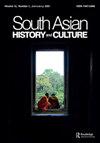Choreographing the queer: Visual and textual stimuli in Mandeep Raikhy’s dance-making process
IF 0.3
0 ASIAN STUDIES
引用次数: 0
Abstract
ABSTRACT The article looks at the methodology used by dance-maker Mandeep Raikhy – for his works Queen Size and A Male Ant Has Straight Antennae - of using ‘stimuli’ in the choreographic process to incite and create appropriate movement principles. The usage of visual stimuli such as images, drawings, and observations, and textual or literary stimuli (fiction/non-fiction, words) can be said to hold the power to evoke ‘authentic’ movement from deep within, which can further be processed into choreography. The kinds of stimuli employed in Raikhy’s process, along with how he processes them, throw an interesting light on the needs of queer dance and choreography, while also expanding on the unique role and power of dance in queer discourse. How do images used by Raikhy metamorphose into movement, and how is movement thus conceived faithful to queerness? In what ways does text act as a motivator in working with a form that defies text? How does bodily text replace it? Once movement is generated from these stimuli, what choices does Raikhy make to choreograph, and how and why is a performance of this choreography effective in delivering a sense of queerness to the spectator (as well as being a political act)?编舞酷儿:曼迪普·赖基舞蹈创作过程中的视觉和文本刺激
摘要本文探讨了舞蹈制作人Mandeep Raikhy在其作品《大号》和《一只雄性蚂蚁有直触角》中使用的方法,即在舞蹈创作过程中使用“刺激”来煽动和创造适当的动作原则。视觉刺激的使用,如图像、绘画和观察,以及文本或文学刺激(小说/非小说、文字),可以说具有从内心深处唤起“真实”运动的力量,这些运动可以进一步加工成舞蹈。Raikhy过程中使用的刺激种类,以及他如何处理这些刺激,为酷儿舞蹈和编舞的需求提供了有趣的线索,同时也扩展了舞蹈在酷儿话语中的独特作用和力量。Raikhy使用的图像是如何转化为运动的?运动是如何忠实于酷儿的?在使用一种与文本相悖的形式时,文本在哪些方面起到了激励作用?正文是如何取代它的?一旦这些刺激产生了动作,Raikhy会做出什么样的选择来编排,这种编排的表演如何以及为什么能有效地向观众传递怪异感(同时也是一种政治行为)?
本文章由计算机程序翻译,如有差异,请以英文原文为准。
求助全文
约1分钟内获得全文
求助全文

 求助内容:
求助内容: 应助结果提醒方式:
应助结果提醒方式:


